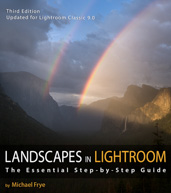In the Moment:
Michael Frye's Landscape Photography Blog
by Michael Frye | Aug 16, 2016 | Night Photography
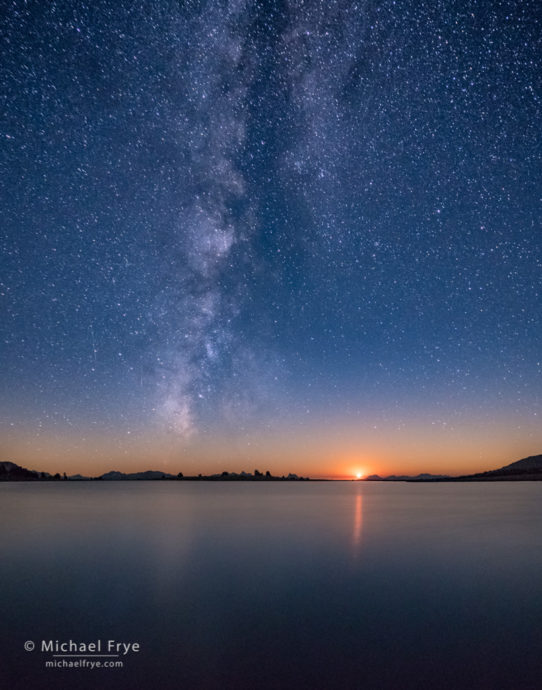
Moon setting over an alpine lake, Yosemite, 1:00 a.m. Friday morning
After our trip to the Alabama Hills Claudia and I drove back up to Yosemite, and on Thursday night we hiked up to an alpine lake to view the peak of the Perseid meteor shower. Knowing that the moon wouldn’t set until nearly 1:00 a.m., we didn’t start hiking until well after dark, and arrived at the lake around 12:30 a.m.
The moon setting over the lake was a beautiful sight. As the moon sank lower it turned orange, just like the setting sun. It also became dimmer, so the stars came out. The extreme contrast made photographing this scene difficult, but when the moon reached a point right above the horizon the contrast dropped just enough, and I was able to capture the image above. In many ways this looks just like a sunset photograph – except for the sky full of stars.
(more…)
by Michael Frye | Aug 14, 2016 | Night Photography
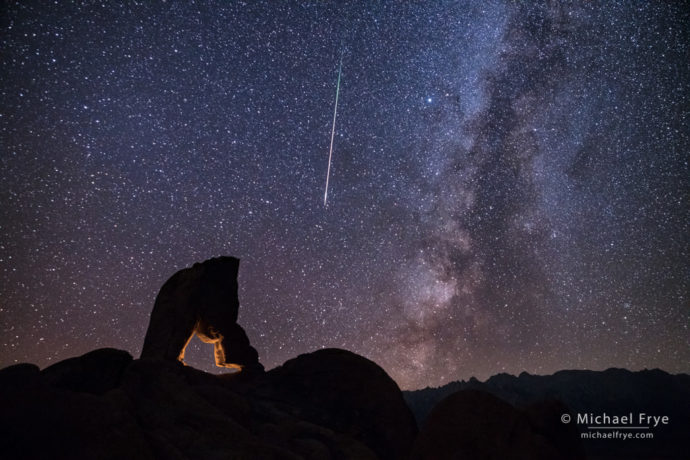
Arch, meteor, and the Milky Way, Alabama Hills near Lone Pine, California. 2:13 a.m. Thursday, August 11th.
After the workshops Claudia and I decided to head down to the Alabama Hills. I’ve been wanting to do some night photography there, and the Perseid meteor shower was nearing its peak. This is typically one of the best meteor showers of the year, but this year was supposed to be exceptionally good, with up to 200 meteors per hour during the peak time early Friday morning.
(more…)
by Michael Frye | Jul 31, 2016 | Composition
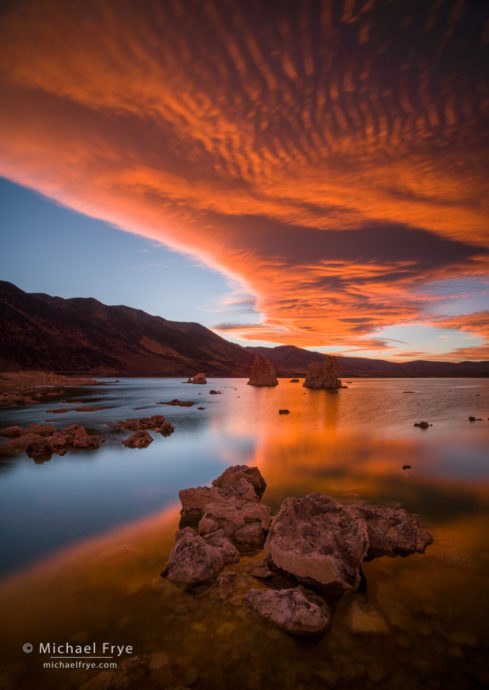
Fiery sunset over Mono Lake, CA, USA
Many books and articles about landscape photography advocate using a wide-angle lens and a low camera position. Certainly wide-angle lenses have their place in landscape photography (though they are not, by any means, the only choice). And getting a wide-angle lens low to the ground and close to some foreground objects can create an exaggerated near-far perspective that gives the photograph a sense of depth.
But a low camera position can also foreshorten the foreground and middle-ground, scrunching them together and merging objects that could and should be separated visually. A higher camera position can often create better separation and spacing between foreground and middle-ground objects, and a better flow to the composition.
Two photographs from Mono Lake might help show what I’m talking about. I made these earlier this summer when some clouds appeared out of nowhere in the middle of a stretch of clear, dry, cloudless weather. In the first of these images (above) there was a spectacular sunset going on above the lake. I might have preferred to have just water and reflections in the foreground, with no rocks, but that wasn’t an option: there were too many rocks, and no way to keep all of them out of the frame if I wanted any water at all in the picture. So I had to work with the rocks, and find a way to incorporate them into the composition.
(more…)
by Michael Frye | Jul 24, 2016 | Light and Weather
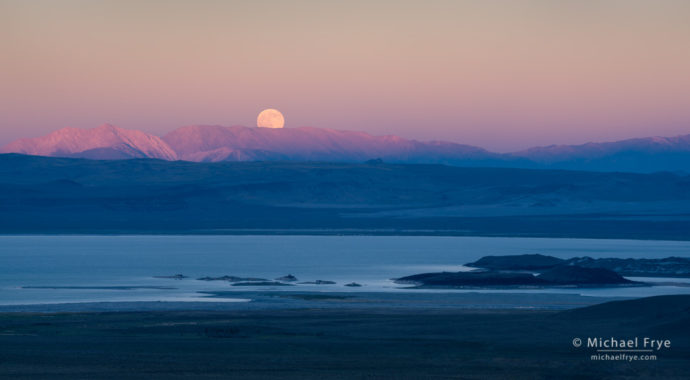
Moon rising above Mono Lake and the White Mountains at sunset, CA, USA
In this previous post I wrote about some of the common misconceptions about photographing the full moon. For example, many people assume that full-moon photographs are taken at night, but in fact most are taken at sunrise or sunset when the light of the moon and landscape are in balance. And it’s often better to take these photographs on the days before or after the actual full moon, not when the calendar says “full moon.” That post helps explain some of the gyrations of the sun and moon so you can understand the best times to photograph the moon above a landscape. There are also some excellent apps that can help you pin down precisely where and when the moon will rise and set. The best of these are PhotoPills and The Photographer’s Ephemeris, and I used both to figure out where and when to take our group during the workshop.
(more…)
by Michael Frye | Jul 10, 2016 | Night Photography
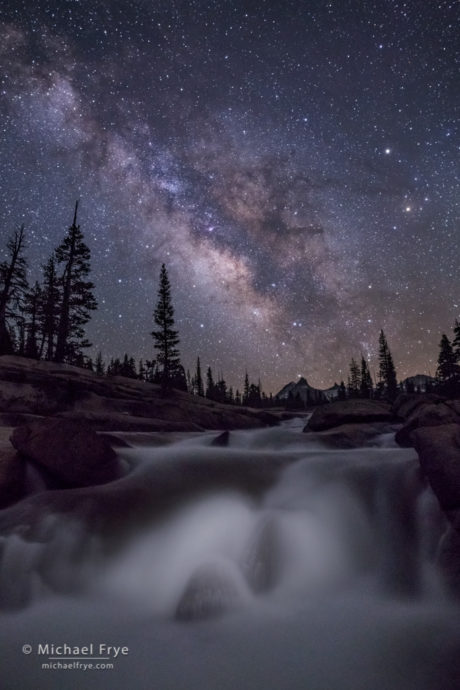
Milky Way over the Tuolumne River, Yosemite; 15 seconds at f/2.8, ISO 6400
On Wednesday afternoon Claudia and I headed up to the beautiful, cool Yosemite high country. We photographed a flower-filled meadow, followed by a picnic dinner at Olmsted Point. Then after sunset we hiked out along the Tuolumne River.
Skies have been clear lately – not ideal for daytime landscapes, but perfect for photographing the night sky. And with a new moon it was the right time to see dark skies with lots of stars. I had used PhotoPills to figure out when the Milky Way would line up above some cascades along the Tuolumne River, which seemed like an interesting combination. But even if that didn’t work, Claudia and I just wanted to get out and enjoy a starry night in the high country.
(more…)
by Michael Frye | Jul 1, 2016 | Announcements
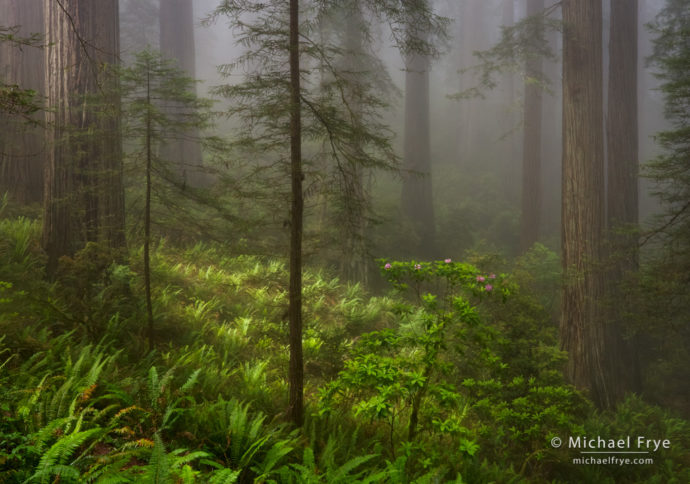
Redwoods, ferns, and rhododendrons near the northern California coast, USA
A few months ago I had the pleasure of talking with Tiffany Briley from Landscape Photography Magazine, and that interview has just been published in the latest issue. Our conversation covered a wide range of subjects, including the importance of light, predicting the weather, sources of inspiration, image processing, and equipment – among many other things.
(more…)
by Michael Frye | Jun 30, 2016 | Light and Weather
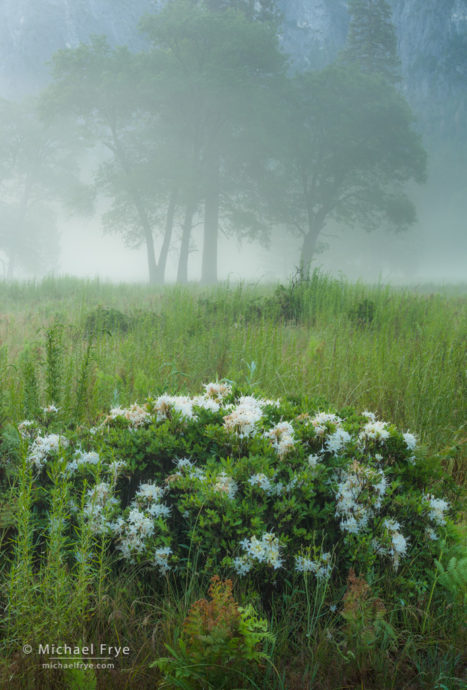
Oaks and azaleas in the fog, Yosemite NP, CA, USA
One of the biggest challenges in landscape photography is deciding where to go and what to photograph. Technical skill and an eye for composition are always important, but it certainly helps to put yourself in the right place at the right time.
Of course everyone has their own preferences about the types of subjects and images they’d like to photograph, and that’s always part of the equation. And different people can have different but equally successful approaches to finding the subject matter that suits them.
(more…)
by Michael Frye | Jun 23, 2016 | Composition
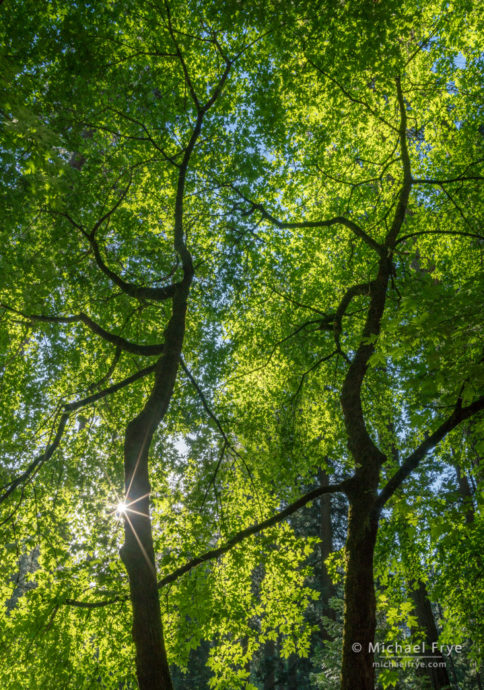
Big-leaf maples in spring, Yosemite NP, CA, USA
A couple of weeks ago Claudia and I were in Yosemite Valley and drove past this maple with beautiful, backlit, bright-green leaves. So we stopped to see if there might be a photograph there. At first I couldn’t find a composition. Although the glowing leaves were beautiful, the light was splotchy, and this tree was right above a tent cabin in Housekeeping Camp, so it was difficult to keep that tent and others out of the picture.
But it seemed like there was something there, so we persisted, me with my big camera, Claudia with her iPhone. The visual clutter caused by the splotchy light, random arrangements of branches, and distracting background objects (the tent cabins) initially seemed to warrant using a telephoto lens, and focusing on a section of the leaves. The longer lens would help simplify things, keep the clutter to a minimum, and focus attention on the leaves themselves, which were what originally caught my eye. But I couldn’t find a group of leaves that had a strong enough pattern, and the photographs didn’t convey the feeling of those glowing leaves.
(more…)
by Michael Frye | Jun 19, 2016 | Announcements

Stars, mist, Three Brothers, and the Merced River, Yosemite NP, CA, USA
Just a reminder that the special Ansel Adams Gallery print sale ends today at 6:00 p.m. Pacific time, so you still have a few hours left to get 25% off two of my images: Stars, Mist, Three Brothers, and the Merced River, and Swirling Mist From Tunnel View. You can see all the details about the sale in this earlier post, or go directly to The Ansel Adams Gallery’s website to purchase a print here.
(more…)
by Michael Frye | Jun 14, 2016 | Announcements

Swirling mist from Tunnel View, Yosemite NP, CA, USA
I’m pleased to announce that once again The Ansel Adams Gallery is sponsoring a special print sale of two of my photographs, at 25% off the normal price. The two images we selected for this offer are Swirling Mist From Tunnel View, Yosemite, and Stars, Mist, Three Brothers, and the Merced River, Yosemite. These two photographs are in my current exhibit at The Ansel Adams Gallery, but otherwise have never been exhibited at a gallery or sold before.
My signed, limited-edition 16×20 prints usually sell for $325, but during this sale you can get one for only $244. Or you can purchase a 20×24 print, normally $475, for only $356. This is a rare chance to purchase one of my photographs at a reduced price, but the sale lasts for just six days, until Sunday, June 19th, at 6:00 PM Pacific time. Visit the Ansel Adams Gallery website to purchase a print or get more details.
Here are the stories behind the photographs:
(more…)

















